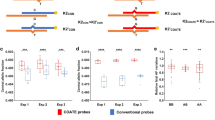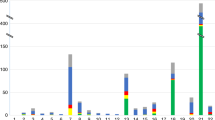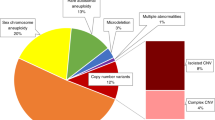Abstract
Prenatal cell-free DNA (cfDNA) screening uses extracellular fetal DNA circulating in the peripheral blood of pregnant women to detect prevalent fetal chromosomal anomalies. However, numerous severe conditions with underlying single-gene defects are not included in current prenatal cfDNA screening. In this prospective, multicenter and observational study, pregnant women at elevated risk for fetal genetic conditions were enrolled for a cfDNA screening test based on coordinative allele-aware target enrichment sequencing. This test encompasses the following three of the most frequent pathogenic genetic variations: aneuploidies, microdeletions and monogenic variants. The cfDNA screening results were compared to invasive prenatal or postnatal diagnostic test results for 1,090 qualified participants. The comprehensive cfDNA screening detected a genetic alteration in 135 pregnancies with 98.5% sensitivity and 99.3% specificity relative to standard diagnostics. Of 876 fetuses with suspected structural anomalies on ultrasound examination, comprehensive cfDNA screening identified 55 (56.1%) aneuploidies, 6 (6.1%) microdeletions and 37 (37.8%) single-gene pathogenic variants. The inclusion of targeted monogenic conditions alongside chromosomal aberrations led to a 60.7% increase (from 61 to 98) in the detection rate. Overall, these data provide preliminary evidence that a comprehensive cfDNA screening test can accurately identify fetal pathogenic variants at both the chromosome and single-gene levels in high-risk pregnancies through a noninvasive approach, which has the potential to improve prenatal evaluation of fetal risks for severe genetic conditions arising from heterogenous molecular etiologies. ClinicalTrials.gov registration: ChiCTR2100045739.
This is a preview of subscription content, access via your institution
Access options
Access Nature and 54 other Nature Portfolio journals
Get Nature+, our best-value online-access subscription
$29.99 / 30 days
cancel any time
Subscribe to this journal
Receive 12 print issues and online access
$209.00 per year
only $17.42 per issue
Buy this article
- Purchase on Springer Link
- Instant access to full article PDF
Prices may be subject to local taxes which are calculated during checkout


Similar content being viewed by others
Data availability
The demographic data, clinical history, prenatal cfDNA screening, diagnostic test results and the diagnostic test methodologies of all 1,090 participants in the final cohort are within the paper and the Extended Data. All the pathogenic single-gene variants and the key phenotypes of the participants are available in the ClinVar database at https://www.ncbi.nlm.nih.gov/clinvar/submitters/508997/. The raw data files for all 1,090 participants are securely stored in an environment compliant with patients’ privacy protection regulations within our laboratory and will be maintained for a minimum of ten years following publication. Access to these raw data files, unfiltered cfDNA gene sequencing data (VCF files) and locus-specific diagnostic sequencing results is available upon request from the corresponding author, J.Z. This process is to assure that patients’ data privacy will be safeguarded and that the data will be used exclusively for noncommercial academic research purposes. All requests for data access must originate from an academic institution and be accompanied by verifiable affiliation (for example, a publicly accessible research investigator profile on the institution’s website). Upon receipt of a qualified request, it will undergo review by a Data Privacy Committee (DPC), composed of two senior investigators from the study and an external reviewer, to verify that the data will be used exclusively for noncommercial, academic research purposes. After DPC approval, the execution of a Data Transfer Agreement is required, which will explicitly stipulate nondisclosure to third party and that the data are to be used solely for noncommercial, academic research activities. Qualified requests will be processed within a 3-week time frame. The hg38 reference genome sequence can be obtained at https://www.ncbi.nlm.nih.gov/datasets/genome/GCF_000001405.40/.
Code availability
Customized computing code used in this study is available at https://github.com/Jinglan1/NIPS2/. Raw FASTQ were filtered and UMI-preprocessed using FASTP 0.21.0, https://github.com/OpenGene/fastp. The clean FASTQ files were aligned to hg38 human reference using BWA 0.7.17-r1188 (https://github.com/lh3/bwa) and then sorted by Samtools 1.9 (https://github.com/samtools/samtools/releases/). Consensus BAM files were generated by Gencore 0.15.0 and then finalized by BaseRecalibrator and ApplyBQSR GATK 4.1.8.0 followed by variant calling (https://gatk.broadinstitute.org). Raw variants were annotated by Annovar v2019-10-24 (https://annovar.openbioinformatics.org/).
References
Congenital disorders. WHO https://www.who.int/news-room/fact-sheets/detail/birth-defects (2023).
Mai, C. T. et al. National population-based estimates for major birth defects, 2010–2014. Birth Defects Res. 111, 1420–1435 (2019).
Bacino, C. A. Congenital anomalies: epidemiology, types, and patterns. UpToDate https://www.uptodate.com/contents/birth-defects-epidemiology-types-and-patterns (2023).
Moore, K. L., Persaud, T. V. N. & Torchia, M. G. The Developing Human: Clinically Oriented Embryology (Elsevier Health Sciences, 2018).
Antonarakis, S. E. Carrier screening for recessive disorders. Nat. Rev. Genet. 20, 549–561 (2019).
American College of Obstetricians and GynecologistsACOG practice bulletin no. 27: clinical management guidelines for obstetrician-gynecologists. Prenatal diagnosis of fetal chromosomal abnormalities. Obstet. Gynecol. 97, (2001).
Weatherall, D. J. Single gene disorders or complex traits: lessons from the thalassaemias and other monogenic diseases. BMJ 321, 1117–1120 (2000).
Van El, C. G. & Cornel, M. C. Genetic testing and common disorders in a public health framework: recommendations of the European Society of Human Genetics. Eur. J. Hum. Genet. 19, S1–S5 (2011).
Lo, Y. M. et al. Presence of fetal DNA in maternal plasma and serum. Lancet 350, 485–487 (1997).
Chiu, R. W. et al. Noninvasive prenatal diagnosis of fetal chromosomal aneuploidy by massively parallel genomic sequencing of DNA in maternal plasma. Proc. Natl Acad. Sci. USA 105, 20458–20463 (2008).
Pergament, E. et al. Single-nucleotide polymorphism-based noninvasive prenatal screening in a high-risk and low-risk cohort. Obstet. Gynecol. 124, 210–218 (2014).
Sentilhes, L., Salomon, L. J. & Vayssiere, C. Cell-free DNA analysis for noninvasive examination of trisomy. N. Engl. J. Med. 373, 2581–2582 (2015).
Snyder, M. W. et al. Copy-number variation and false positive prenatal aneuploidy screening results. N. Engl. J. Med. 372, 1639–1645 (2015).
Bianchi, D. W. et al. DNA sequencing versus standard prenatal aneuploidy screening. N. Engl. J. Med. 370, 799–808 (2014).
Norton, M. E. et al. Cell-free DNA analysis for noninvasive examination of trisomy. N. Engl. J. Med. 372, 1589–1597 (2015).
Rafalko, J. et al. Genome-wide cell-free DNA screening: a focus on copy-number variants. Genet. Med. 23, 1847–1853 (2021).
Liang, D. et al. Clinical utility of noninvasive prenatal screening for expanded chromosome disease syndromes. Genet. Med. 21, 1998–2006 (2019).
Dar, P. et al. Cell-free DNA screening for prenatal detection of 22q11.2 deletion syndrome. Am. J. Obstet. Gynecol. 227, 79.e1–79.e11 (2022).
Saito, H., Sekizawa, A., Morimoto, T., Suzuki, M. & Yanaihara, T. Prenatal DNA diagnosis of a single-gene disorder from maternal plasma. Lancet 356, 1170 (2000).
Chitty, L. S. et al. New aids for the non-invasive prenatal diagnosis of achondroplasia: dysmorphic features, charts of fetal size and molecular confirmation using cell-free fetal DNA in maternal plasma. Ultrasound Obstet. Gynecol. 37, 283–289 (2011).
Amicucci, P., Gennarelli, M., Novelli, G. & Dallapiccola, B. Prenatal diagnosis of myotonic dystrophy using fetal DNA obtained from maternal plasma. Clin. Chem. 46, 301–302 (2000).
Chitty, L. S. et al. Safe, accurate, prenatal diagnosis of thanatophoric dysplasia using ultrasound and free fetal DNA. Prenat. Diagn. 33, 416–423 (2013).
Chitty, L. S. et al. Non-invasive prenatal diagnosis of achondroplasia and thanatophoric dysplasia: next-generation sequencing allows for a safer, more accurate, and comprehensive approach. Prenat. Diagn. 35, 656–662 (2015).
Mellis, R., Chandler, N., Jenkins, L. & Chitty, L. S. The role of sonographic phenotyping in delivering an efficient noninvasive prenatal diagnosis service for FGFR3-related skeletal dysplasias. Prenat. Diagn. 40, 785–791 (2020).
Mohan, P. et al. Clinical experience with non-invasive prenatal screening for single-gene disorders. Ultrasound Obstet. Gynecol. 59, 33–39 (2022).
Zhang, J. et al. Non-invasive prenatal sequencing for multiple Mendelian monogenic disorders using circulating cell-free fetal DNA. Nat. Med. 25, 439–447 (2019).
Adams, S. et al. Single gene non-invasive prenatal screening for autosomal dominant conditions in a high-risk cohort. Prenat. Diagn. 33, 416–423 (2023).
Yang, Y. et al. Clinical whole-exome sequencing for the diagnosis of Mendelian disorders. N. Engl. J. Med. 369, 1502–1511 (2013).
Yang, Y. et al. Molecular findings among patients referred for clinical whole-exome sequencing. JAMA 312, 1870–1879 (2014).
Petrovski, S. et al. Whole-exome sequencing in the evaluation of fetal structural anomalies: a prospective cohort study. Lancet 393, 758–767 (2019).
Lord, J. et al. Prenatal exome sequencing analysis in fetal structural anomalies detected by ultrasonography (PAGE): a cohort study. Lancet 393, 747–757 (2019).
Krakow, D., Lachman, R. S. & Rimoin, D. L. Guidelines for the prenatal diagnosis of fetal skeletal dysplasias. Genet. Med. 11, 127–133 (2009).
Xu, C. et al. Genetic deconvolution of fetal and maternal cell-free DNA in maternal plasma enables next-generation non-invasive prenatal screening. Cell Discov. 8, 109 (2022).
Kitzman, J. O. et al. Noninvasive whole-genome sequencing of a human fetus. Sci. Transl. Med. 4, 137ra176 (2012).
Hall, M. P. et al. Non-invasive prenatal detection of trisomy 13 using a single nucleotide polymorphism- and informatics-based approach. PLoS ONE 9, e96677 (2014).
Yu, S. C. et al. Size-based molecular diagnostics using plasma DNA for noninvasive prenatal testing. Proc. Natl Acad. Sci. USA 111, 8583–8588 (2014).
Sun, K. et al. Size-tagged preferred ends in maternal plasma DNA shed light on the production mechanism and show utility in noninvasive prenatal testing. Proc. Natl Acad. Sci. USA 115, E5106–E5114 (2018).
Koumbaris, G. et al. Targeted capture enrichment followed by NGS: development and validation of a single comprehensive NIPT for chromosomal aneuploidies, microdeletion syndromes and monogenic diseases. Mol. Cytogenet. 12, 48 (2019).
Rabinowitz, T. et al. Bayesian-based noninvasive prenatal diagnosis of single-gene disorders. Genome Res. 29, 428–438 (2019).
Serpas, L. et al. Dnase1l3 deletion causes aberrations in length and end-motif frequencies in plasma DNA. Proc. Natl Acad. Sci. USA 116, 641–649 (2019).
Che, H. et al. Noninvasive prenatal diagnosis by genome-wide haplotyping of cell-free plasma DNA. Genet. Med. 22, 962–973 (2020).
Lebo, R. V. et al. Discordant circulating fetal DNA and subsequent cytogenetics reveal false negative, placental mosaic, and fetal mosaic cfDNA genotypes. J. Transl. Med. 13, 260 (2015).
Brison, N. et al. Predicting fetoplacental chromosomal mosaicism during non-invasive prenatal testing. Prenat. Diagn. 38, 258–266 (2018).
Kim, Y. J., Lee, J. E., Kim, S. H., Shim, S. S. & Cha, D. H. Maternal age-specific rates of fetal chromosomal abnormalities in Korean pregnant women of advanced maternal age. Obstet. Gynecol. Sci. 56, 160–166 (2013).
Zhu, H. et al. Efficiency of non-invasive prenatal screening in pregnant women at advanced maternal age. BMC Pregnancy Childbirth 21, 86 (2021).
Toriello, H. V. & Meck, J. M. Statement on guidance for genetic counseling in advanced paternal age. Genet. Med. 10, 457–460 (2008).
Janeczko, D., Hołowczuk, M., Orzeł, A., Klatka, B. & Semczuk, A. Paternal age is affected by genetic abnormalities, perinatal complications and mental health of the offspring. Biomed. Rep. 12, 83–88 (2020).
Larroya, M. et al. Have maternal or paternal ages any impact on the prenatal incidence of genomic copy number variants associated with fetal structural anomalies? PLoS ONE 16, e0253866 (2021).
Nwakalor, C., Said-Delgado, S., Krinshpun, S. & Velinov, M. De novo HRAS gene mutation associated with Costello syndrome identified by non-invasive cell-free fetal DNA screening. Prenat. Diagn. 41, 11–14 (2021).
American College of Obstetricians and Gynecologists’ Committee on Practice Bulletins—Obstetrics; Committee on Genetics; Society for Maternal-Fetal Medicine Screening for fetal chromosomal abnormalities: ACOG practice bulletin, number 226. Obstet. Gynecol. 136, e48–e69 (2020).
Goldberg, J. D., Pierson, S. & Johansen Taber, K. Expanded carrier screening: what conditions should we screen for? Prenat. Diagn. 43, 496–505 (2023).
Lazarin, G. A. et al. Systematic classification of disease severity for evaluation of expanded carrier screening panels. PLoS ONE 9, e114391 (2014).
Strande, N. T. et al. Evaluating the clinical validity of gene-disease associations: an evidence-based framework developed by the clinical genome resource. Am. J. Hum. Genet. 100, 895–906 (2017).
Gelb, B. D. et al. ClinGen’s RASopathy Expert Panel consensus methods for variant interpretation. Genet. Med. 20, 1334–1345 (2018).
Botkin, J. R. et al. Points to consider: ethical, legal, and psychosocial implications of genetic testing in children and adolescents. Am. J. Hum. Genet. 97, 6–21 (2015).
Andrews, L. B., Fullarton, J. E., Holtzman, N. A. & Motulsky, A. G. (eds.). Assessing Genetic Risks: Implications for Health and Social Policy (National Academies Press, 1994).
Minear, M. A., Alessi, S., Allyse, M., Michie, M. & Chandrasekharan, S. Noninvasive prenatal genetic testing: current and emerging ethical, legal, and social issues. Annu. Rev. Genomics Hum. Genet. 16, 369–398 (2015).
Polygenic Risk Score Task Force of the International Common Disease Alliance Responsible use of polygenic risk scores in the clinic: potential benefits, risks and gaps. Nat. Med. 27, 1876–1884 (2021).
Xu, C. et al. Comprehensive non-invasive prenatal screening for pregnancies with elevated risks of genetic disorders: protocol for a prospective, multicentre study. BMJ Open 11, e053617 (2021).
Richards, S. et al. Standards and guidelines for the interpretation of sequence variants: a joint consensus recommendation of the American College of Medical Genetics and Genomics and the Association for Molecular Pathology. Genet. Med. 17, 405–424 (2015).
Riggs, E. R. et al. Technical standards for the interpretation and reporting of constitutional copy-number variants: a joint consensus recommendation of the American College of Medical Genetics and Genomics (ACMG) and the Clinical Genome Resource (ClinGen). Genet. Med. 22, 245–257 (2020).
Acknowledgements
We would like to thank M. He, X. Liu, X. Xu, R. Jing, D. Pan, X. Zhao, J. Wang and X. Cai for their assistance in sample processing in the laboratory. We are grateful for X. Zhai’s invaluable insights and guidance in the formulation of clinical prioritization framework for conditions to be screened in the general population. We appreciate and thank H. Zhang’s administrative efforts in the coordination of sample collection and clinical follow-up. We thank J. Semotok, X. Luo, C. Wang and W. Jiang for their critical reading of the manuscript. The clinical study was supported by the National Key Research and Development Program of China (2023YFC2705600, 2023YFC2705601, 2020YFA0804000, 2020YFA0804001, 2022YFC2703500, 2021YFC2700701, 2018YFC1002804, 2021YFC2701002 and 2022YFC2703701) and BioBiggen Technology Co. We are indebted to the funding agencies to support the follow-up study from the National Natural Science Foundation of China (82071661, 81661128010, 82088102, 82171686, 81971344, 82171677, 82192864, 81901495, 81974224 and 82394424), Technology Innovation Project of Shanghai Shenkang Hospital Development Center (SHDC2020CR1008A, SHDC12019107, SHDC12023120 and SHDC12018X17), the International Science and Technology Collaborative Fund of Shanghai (18410711800), CAMS Innovation Fund for Medical Sciences (2019-12M-5-064), Program of Shanghai Academic Research Leader (20XD1424100), Outstanding Youth Medical Talents of Shanghai Rising Stars of Medical Talent Youth Development Program, Shanghai Frontiers Science Research Base of Reproduction and Development, the Shanghai Municipal Commission of Science and Technology Program (21Y21901002, 22S31901500), Shanghai Municipal Health Commission (GW-10.1-XK07), Clinical Research Project of Shanghai Municipal Health Commission (201840210, 20184Y0349 and 202140110), Key Discipline Construction Project (2023-2025) of Three-Year Initiative Plan for Strengthening Public Health System Construction in Shanghai (GWVI-11.1-35), Major Scientific and Technological Projects for collaborative prevention and control of birth defects in Hunan Province (2019SK1010) and the Key Research and Development Program of Zhejiang Province (2021C03098).
Author information
Authors and Affiliations
Contributions
H.H., J.Z., C.-M.X., D.Z. and H.W. designed the study. H.H., J.Z., C.-M.X., D.Z., H.W., Y.W., S.C., Q.L., H.X., B.Y., C.Z., C.Y., C-J.X., J.L., J.S., M.D., N.M., P.C., W.L., X.Q., X.-M.Q., X.L., Y.L., Y.J., Y.P., Y.X., Y.C., Y.R. and Z.Z. conducted the clinical analyses. J.Z., J.L. and X-M.Q. conducted the statistical analyses. J.Z. wrote the paper. H.H., J.Z., D.Z., H.W. and C.-M.X. supervised the project.
Corresponding authors
Ethics declarations
Competing interests
J.Z., J.L., X.-M.Q. and Z.Z. are employees or shareholders of Beijing BioBiggen Technology or its subsidiaries and affiliates. A patent for the comprehensive noninvasive prenatal screening has been granted to the Beijing BioBiggen Technology (J.Z., J.L. and Z.Z.). The other authors declare no conflict of interest related to this work.
Peer review
Peer review information
Nature Medicine thanks Josephine Johnston, Dena Matalon, and the other, anonymous, reviewer(s) for their contribution to the peer review of this work. Primary Handling Editor: Anna Maria Ranzoni, in collaboration with the Nature Medicine team.
Additional information
Publisher’s note Springer Nature remains neutral with regard to jurisdictional claims in published maps and institutional affiliations.
Extended data
Extended Data Fig. 1 The illustration of a comprehensive prenatal cell-free DNA screening test.
The comprehensive prenatal cfDNA screening methodology utilizes a multi-faceted approach, involving new laboratory technologies, genomic algorithms and specialized condition interpretation analytics. Top panels: the test employs a tailored sequencing library construction process that combines customized adaptors for improved ligation efficiency, molecular indexing to curtail PCR-induced errors and capture-based hybridization to reduce allele drop-out, significantly increasing overall test accuracy for different types of genetic variants. Central to the method are the coordinative allele-aware target enrichment (COATE) probes which are designed to minimize the difference in hybridization equilibrium constants between reference and alternative alleles, which may not be perfectly complementary to either the wild-type or variant allele but reduce the enrichment bias introduced by conventional probes. Middle panels: fetus-specific genomic features, including cfDNA fragment length, meiotic error origin, meiotic recombination and recombination breakpoints, are used together to discern fetal monogenic and chromosomal variants. Bottom panels: condition-specific analytics are used for the interpretation of genetic variants following the American College of Medical Genetics guidelines on the analyses of sequence variants and chromosome copy-number variations. Only those classified as pathogenic or likely pathogenic variants following these guidelines are reported.
Supplementary information
Rights and permissions
Springer Nature or its licensor (e.g. a society or other partner) holds exclusive rights to this article under a publishing agreement with the author(s) or other rightsholder(s); author self-archiving of the accepted manuscript version of this article is solely governed by the terms of such publishing agreement and applicable law.
About this article
Cite this article
Zhang, J., Wu, Y., Chen, S. et al. Prospective prenatal cell-free DNA screening for genetic conditions of heterogenous etiologies. Nat Med 30, 470–479 (2024). https://doi.org/10.1038/s41591-023-02774-x
Received:
Accepted:
Published:
Issue Date:
DOI: https://doi.org/10.1038/s41591-023-02774-x



